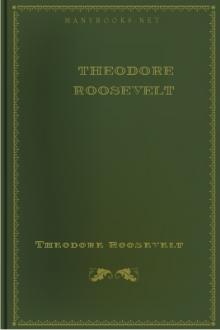Theodore Roosevelt by Theodore Roosevelt (read this if .TXT) 📕

- Author: Theodore Roosevelt
- Performer: -
Book online «Theodore Roosevelt by Theodore Roosevelt (read this if .TXT) 📕». Author Theodore Roosevelt
Ambassador, you haven’t taken off your gloves,” to which he promptly responded, “I think I will leave them on; we might meet ladies!”
We liked Rock Creek for these walks because we could do so much scrambling and climbing along the cliffs; there was almost as much climbing when we walked down the Potomac to Washington from the Virginia end of the Chain Bridge. I would occasionally take some big-game friend from abroad, Selous or St. George Littledale or Captain Radclyffe or Paul Niedicke, on these walks. Once I invited an entire class of officers who were attending lectures at the War College to come on one of these walks; I chose a route which gave us the hardest climbing along the rocks and the deepest crossings of the creek; and my army friends enjoyed it hugely—being the right sort, to a man.
On March 1, 1909, three days before leaving the Presidency, various members of the Tennis Cabinet lunched with me at the White House.
“Tennis Cabinet” was an elastic term, and of course many who ought to have been at the lunch were, for one reason or another, away from Washington; but, to make up for this, a goodly number of out-of-town honorary members, so to speak, were present—for instance, Seth Bullock; Luther Kelly, better known as Yellowstone Kelly in the days when he was an army scout against the Sioux; and Abernathy, the wolf-hunter. At the end of the lunch Seth Bullock suddenly reached forward, swept aside a mass of flowers which made a centerpiece on the table, and revealed a bronze cougar by Proctor, which was a parting gift to me. The lunch party and the cougar were then photographed on the lawn.
Some of the younger officers who were my constant companions on these walks and rides pointed out to me the condition of utter physical worthlessness into which certain of the elder ones had permitted themselves to lapse, and the very bad effect this would certainly have if ever the army were called into service. I then looked into the matter for myself, and was really shocked at what I found. Many of the older officers were so unfit physically that their condition would have excited laughter, had it not been so serious, to think that they belonged to the military arm of the Government. A cavalry colonel proved unable to keep his horse at a smart trot for even half a mile, when I visited his post; a Major-General proved afraid even to let his horse canter, when he went on a ride with us; and certain otherwise good men proved as unable to walk as if they had been sedentary brokers. I consulted with men like Major-Generals Wood and Bell, who were themselves of fine physique, with bodies fit to meet any demand.
It was late in my administration; and we deemed it best only to make a beginning—experience teaches the most inveterate reformer how hard it is to get a totally non-military nation to accept seriously any military improvement. Accordingly, I merely issued directions that each officer should prove his ability to walk fifty miles, or ride one hundred, in three days.
This is, of course, a test which many a healthy middle-aged woman would be able to meet. But a large portion of the press adopted the view that it was a bit of capricious tyranny on my part; and a considerable number of elderly officers, with desk rather than field experience, intrigued with their friends in Congress to have the order annulled. So one day I took a ride of a little over one hundred miles myself, in company with Surgeon-General Rixey and two other officers.
The Virginia roads were frozen and in ruts, and in the afternoon and evening there was a storm of snow and sleet; and when it had been thus experimentally shown, under unfavorable conditions, how easy it was to do in one day the task for which the army officers were allowed three days, all open objection ceased. But some bureau chiefs still did as much underhanded work against the order as they dared, and it was often difficult to reach them. In the Marine Corps Captain Leonard, who had lost an arm at Tientsin, with two of his lieutenants did the fifty miles in one day; for they were vigorous young men, who laughed at the idea of treating a fifty-mile walk as over-fatiguing. Well, the Navy Department officials rebuked them, and made them take the walk over again in three days, on the ground that taking it in one day did not comply with the regulations! This seems unbelievable; but Leonard assures me it is true. He did not inform me at the time, being afraid to “get in wrong” with his permanent superiors. If I had known of the order, short work would have been made of the bureaucrat who issued it.[*]
[*] One of our best naval officers sent me the following letter, after the above had appeared:—
“I note in your Autobiography now being published in the Outlook that you refer to the reasons which led you to establish a physical test for the Army, and to the action you took (your 100-mile ride) to prevent the test being abolished. Doubtless you did not know the following facts:
“1. The first annual navy test of 50 miles in three days was subsequently reduced to 25 miles in two days in each quarter.
“2. This was further reduced to 10 miles each month, which is the present ‘test,’ and there is danger lest even this utterly insufficient test be abolished.
“I enclose a copy of a recent letter to the Surgeon General which will show our present deplorable condition and the worse condition into which we are slipping back.
“The original test of 50 miles in three days did a very great deal of good. It decreased by thousands of dollars the money expended on street car fare, and by a much greater sum the amount expended over the bar. It eliminated a number of the wholly unfit; it taught officers to walk; it forced them to learn the care of their feet and that of their men; and it improved their general health and was rapidly forming a taste for physical exercise.”
The enclosed letter ran in part as follows:—
“I am returning under separate cover ‘The Soldiers’ Foot and the Military Shoe.’
“The book contains knowledge of a practical character that is valuable for the men who HAVE TO MARCH, WHO HAVE SUFFERED FROM
FOOT TROUBLES, AND WHO MUST AVOID THEM IN ORDER TO ATTAIN
EFFICIENCY.
“The words in capitals express, according to my idea, the gist of the whole matter as regards military men.
“The army officer whose men break down on test gets a black eye.
The one whose men show efficiency in this respect gets a bouquet.
“To such men the book is invaluable. There is no danger that they will neglect it. They will actually learn it, for exactly the same reasons that our fellows learn the gunnery instructions—or did learn them before they were withdrawn and burned.
“B U T, I have not been able to interest a single naval officer in this fine book. They will look at the pictures and say it is a good book, but they won’t read it. The marine officers, on the contrary, are very much interested, because they have to teach their men to care for their feet and they must know how to care for their own. But the naval officers feel no such necessity, simply because their men do not have to demonstrate their efficiency by practice marches, and they themselves do not have to do a stunt that will show up their own ignorance and inefficiency in the matter.
“For example, some time ago I was talking with some chaps about shoes—the necessity of having them long enough and wide enough, etc., and one of them said: ‘I have no use for such shoes, as I never walk except when I have to, and any old shoes do for the 10-mile-a-month stunt,’ so there you are!
“When the first test was ordered, Edmonston (Washington shoe man) told me that he sold more real walking shoes to naval officers in three months than he had in the three preceding years. I know three officers who lost both big-toe nails after the first test, and another who walked nine miles in practice with a pair of heavy walking shoes that were too small and was laid up for three days—
could not come to the office. I know plenty of men who after the first test had to borrow shoes from larger men until their feet ‘went down’ to their normal size.
“This test may have been a bit too strenuous for old hearts (of men who had never taken any exercise), but it was excellent as a matter of instruction and training of handling feet—and in an emergency (such as we soon may have in Mexico) sound hearts are not much good if the feet won’t stand.
“However, the 25-mile test in two days each quarter answered the same purpose, for the reason that 12.5 miles will produce sore feet with bad shoes, and sore feet and lame muscles even with good shoes, if there has been no practice marching.
“It was the necessity of doing 12.5 MORE MILES ON THE SECOND DAY
WITH SORE FEET AND LAME MUSCLES that made ‘em sit up and take notice—made ‘em practice walking, made ‘em avoid street cars, buy proper shoes, show some curiosity about sox and the care of the feet in general.
“All this passed out with the introduction of the last test of 10
miles a month. As one fellow said: ‘I can do that in sneakers’—
but he couldn’t if the second day involved a tramp on the sore feet.
“The point is that whereas formerly officers had to practice walking a bit and give some attention to proper footgear, now they don’t have to, and the natural consequence is that they don’t do it.
“There are plenty of officers who do not walk any more than is necessary to reach a street car that will carry them from their residences to their offices. Some who have motors do not do so much. They take no exercise. They take cocktails instead and are getting beefy and ‘ponchy,’ and something should be done to remedy this state of affairs.
“It would not be necessary if service





Comments (0)